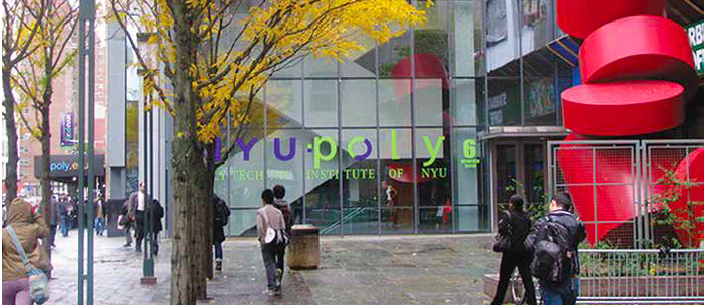On January 30th leaders from science, engineering, higher education, business and government met at the Brooklyn Academy of Music to celebrate the union of New York University and the Polytechnic School of Engineering.
While the official merger happened on January 1st, 2014, the relationship between the schools is longstanding. The NYU Polytechnic School of Engineering dates back to 1854, the same year the Brooklyn Poly and the NYU School of Civil Engineering and Architecture were founded.
Due to financial troubles, in the 1970s NYU sold its University Heights campus that housed the engineering school. In fact, it was this deal that gave NYU the economic means to grow. In 1973 Brooklyn Poly acquired the faculty and programs of NYU’s School of Engineering and Science, forming Polytechnic University. NYU then became known as a heady blend of humanities, law, and research/medicine, and Polytechnic as a school where immigrants, minorities, and low-income people could find opportunity as engineers and researchers.
Despite their differences, both schools have been identified as strong educational traditions in New York City. In 2008 they became affiliated with each other once again, eventually leading to the official merger in 2014.
“This completion enables us now to pay full attention to the real task ahead of us. That task is to integrate modern technology with humanities and social sciences in service of the city, the state, and the nation. That task is to provide balanced education to students, who will then be greatly prepared to create a better world in the service of all,” said NYU-Polytechnic President and Dean of Engineering Katepalli Sreenivasan.
The merger has brought on massive sharing of resources, information, and talent between the schools, leading to standout curricula and programs at NYU-Poly. For example, the annual Inno/Vention competition gives students the opportunity to work with professors and industry leaders, prototyping and pitching commercially viable solutions to real-world problems. The goal is to create a culture of positive competition at the School of Engineering, in order to spur innovation and entrepreneurship. The new MAGNET facility brings together the NYU schools the Arts, Education, Engineering, and Math, to create fresh and unusual collaborations. The Game Innovation Lab focuses on the power of gaming as an educational tool, as well at its capacity to expand NYC’s economic sector.
To some folks looking in, the merger appears as more of the same—the “NYU-ization” of NYC. Except this time, hipsters are taking over Brooklyn to study things like engineering, urban design, and game programming. However, students and stakeholders have both voiced the opinion that the relationship is mutually beneficial. NYU branches out, improving its standing in STEM fields (science, technology, engineering, and mathematics) as well promoting ethnic and cultural diversity at its campuses. Polytechnic benefits by getting the support and clout of a major institution like NYU.
The fact that the merger celebration happened in Brooklyn seemed significant. NYU President John Sexton proudly displayed his native roots, bearing a thick Brooklyn accent and matter-of-fact way of talking.
“This is a deeply personal moment for me,” Sexton said. “It’s personal because we’re just a few blocks from the college where I was chairman of the religion department, before I went to law school. We’re just a few blocks from the house where Lisa and I where married. We’re in the building where I graduated high school. We’re four blocks from my father’s law office…”
Dean Sreenivasan spoke at the celebration about NYU-Polytechnic’s commitment to diversity and economic opportunity. 40 percent of NYU-Poly undergrads are the first in their families to attend college, and even more than that receive Pell grants, given to low-income families. To many students, studying engineering at NYU-Poly is a path to the upward mobility. NYU-Poly also conducts the largest K-12 STEM programs in NYC, sending grad students to 18 schools to teach a hands-on robotics program awarded by the National Science Foundation. The program has been shown to improve participants’ grades overall by more than 50 percent.
A central theme drawn out at the celebration was the idea that the NYU-Poly merger, by synthesizing traditions and skill-sets, will result in real social and economic progress. NYU-Poly engineers will become the next generation of leaders and social architects— possessing advanced knowledge of science and technology, and the willpower to apply these fields to the benefit of humanity.
“Here we are and what we celebrate today is two institutions coming together that share a DNA. Not just a DNA of aspiration, but a DNA that’s caught in so much in the student body at Poly and the student body at NYU—the DNA of New York City and Brooklyn,” Sexton said. “In our essential DNA we are at base immigrants. 40 percent of this city, and even more of Brooklyn are immigrants. And every immigrant share’s one single thing (they may have different religions, different, languages, different food, different music), but they share one thing—they want a better tomorrow. They believe in the progress of humankind. They want to sacrifice forward. They’re not satisfied. They have what I call, ‘an affirmative lack of contentment.’ And that is the basic DNA of NYU and it’s the basic DNA of Poly. So as good as today is, tomorrow will be better, and the day after that better, and I can’t imagine what it’s going to be like in ten years…”

